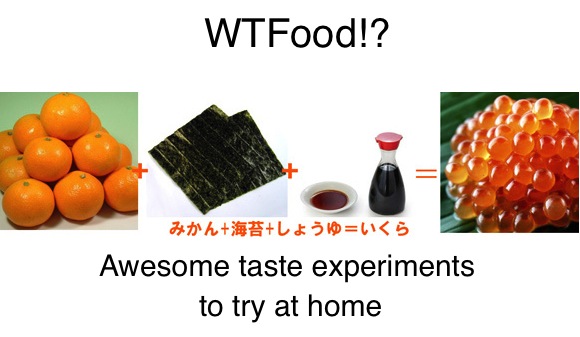
Have you ever had an experience when you ate two different foods at once, and the resulting flavor tasted like a completely different food? If yes, then don’t worry, because apparently your taste buds aren’t going crazy. Kyushu University in Japan recently publicized a list of different food combinations that mirror this phenomenon based on actual scientific research. Some of them are so outrageous that you won’t believe it until you actually try making them yourself!
Here’s a little question to get you started: What two food items should you combine in order to produce the flavor of corn soup? The answer and four more recipes after the jump.
Last year, Dr. Kiyoshi Toko of the Graduate School of Information Science and Electrical Engineering at Kyushu University became the recipient of a Medal of Honor with Purple Ribbon for his laboratory’s successful contributions in the area of calculating taste (sounds weird, right?). This prestigious award has been bestowed by the Japanese government since 1955 to “individuals who have contributed to academic and artistic developments, improvements and accomplishments.”
Using numerical readings of the ‘taste sensor’ device developed in their laboratory, his team tried combining different base ingredients to create entirely different foods. Keep in mind that the taste reading of the concocted foods was always equivalent to the taste reading of a sample of the actual foods.
Let’s take a look at how you too can reproduce five of these scientific “recipes”!
▼Mikan (orange) + nori (seaweed) + soy sauce = ikura (salmon roe)
Remove two sections of a mikan orange and wrap them in one sheet of nori. If you add a few drops of soy sauce, you’ll be rewarded with the taste of delicious salmon roe! The texture of the juicy orange is even said to mimic the sensation of eating the fish eggs. Mmmm!
▼Milk + pickled daikon = corn soup
Heat 100cc of milk until just before it’s boiling, add some thinly sliced pieces of pickled daikon, and then wait 10 minutes. The timing is critical because if you don’t wait long enough, the resulting concoction will just taste like, well, milk, but if you wait too long, the flavor of the pickled daikon will become overpowering.
▼Yogurt + tofu = rare cheesecake (a no-bake Japanese version of cheesecake, usually hardened with gelatin)
If you mix 20 grams of yogurt with 10 grams of tofu, the resulting acidity and depth of flavor is supposedly spot-on. You can also try combining tofu with lemon juice and fresh cream for a similar effect.
▼Yamaimo (mountain yam) + tofu + salt & pepper = white sauce (creamy sauce)
Combine 100 grams of strained tofu together with 100 grams of grated yamaimo, and finally sprinkle with salt and pepper. If you cook the mixture in the oven it will become exactly like creamy sauce, with less than half the calories! Sounds like a golden diet food.
▼Chicken liver + mayonnaise = foie gras
If this true, what a great trick to indulge in classy/cruel food without breaking your wallet or angering animals rights activists! Soak 15 grams of bloodless chicken liver in ice water for about 30 minutes, then smear it with mayonnaise. Let it sit for one night before cooking. The mayonnaise and saltiness are said to bring out the hidden taste potential in the chicken liver.
If those weren’t enough for you, check out these bonus recipes! Some of them look a bit too unappetizing for us to want to even try. Any takers out there?
Yokan (sweet bean jelly) + butter = sweet potato
Vanilla ice cream + soy sauce = mitarashi-dango (a kind of dumpling made from rice flour with a sweet soy sauce glaze)
Amanatto (sugared red beans) + brandy = marron glacé (a chestnut confection)
Silk tofu + chocolate sauce = almond jelly
Japanese pudding + soy sauce = sea urchin
Avocado + soy sauce = ootoro (fatty tuna)
Soy sauce ramen + vanilla ice cream = pork ramen
Yakisoba (fried noodles) + Japanese pudding = carbonara
Oolong tea + carbonated water = beer
Black tea + lemon + fresh cream = amazake (sweet drink made from fermented rice)






 Sesame Street Fighter, the most badass children’s TV show ever (if only there were a show for it)
Sesame Street Fighter, the most badass children’s TV show ever (if only there were a show for it) You need to follow this Instagram account if you are learning Japanese
You need to follow this Instagram account if you are learning Japanese Japan gets swept up in creative new “cherry toast” trend 【Photos】
Japan gets swept up in creative new “cherry toast” trend 【Photos】 Rice made out of soybeans is coming
Rice made out of soybeans is coming Starbucks unveils new festive Christmas Frappuccinos and drinkware for 2021
Starbucks unveils new festive Christmas Frappuccinos and drinkware for 2021 McDonald’s new Happy Meals offer up cute and practical Sanrio lifestyle goods
McDonald’s new Happy Meals offer up cute and practical Sanrio lifestyle goods More foreign tourists than ever before in history visited Japan last month
More foreign tourists than ever before in history visited Japan last month All-you-can-drink Starbucks and amazing views part of Tokyo’s new 170 meter-high sky lounge
All-you-can-drink Starbucks and amazing views part of Tokyo’s new 170 meter-high sky lounge Starbucks reopens at Shibuya Scramble Crossing with new look and design concept
Starbucks reopens at Shibuya Scramble Crossing with new look and design concept The oldest tunnel in Japan is believed to be haunted, and strange things happen when we go there
The oldest tunnel in Japan is believed to be haunted, and strange things happen when we go there Dogs now allowed on Catbus! Ghibli Park vehicles revise service animal policy
Dogs now allowed on Catbus! Ghibli Park vehicles revise service animal policy Our reporter takes her 71-year-old mother to a visual kei concert for the first time
Our reporter takes her 71-year-old mother to a visual kei concert for the first time Arrest proves a common Japanese saying about apologies and police
Arrest proves a common Japanese saying about apologies and police Tokyo’s most famous arcade announces price increase, fans don’t seem to mind at all
Tokyo’s most famous arcade announces price increase, fans don’t seem to mind at all Beautiful Sailor Moon manhole cover coasters being given out for free by Tokyo tourist center
Beautiful Sailor Moon manhole cover coasters being given out for free by Tokyo tourist center Disney princesses get official manga makeovers for Manga Princess Cafe opening in Tokyo
Disney princesses get official manga makeovers for Manga Princess Cafe opening in Tokyo We try out “Chan Ramen”, an underground type of ramen popular in the ramen community
We try out “Chan Ramen”, an underground type of ramen popular in the ramen community Beautiful new Final Fantasy T-shirt collection on the way from Uniqlo【Photos】
Beautiful new Final Fantasy T-shirt collection on the way from Uniqlo【Photos】 Foreign English teachers in Japan pick their favorite Japanese-language phrases【Survey】
Foreign English teachers in Japan pick their favorite Japanese-language phrases【Survey】 Is the new Shinkansen Train Desk ticket worth it?
Is the new Shinkansen Train Desk ticket worth it? There’s a park inside Japan where you can also see Japan inside the park
There’s a park inside Japan where you can also see Japan inside the park Japanese convenience store packs a whole bento into an onigiri rice ball
Japanese convenience store packs a whole bento into an onigiri rice ball Studio Ghibli releases Kiki’s Delivery Service chocolate cake pouches in Japan
Studio Ghibli releases Kiki’s Delivery Service chocolate cake pouches in Japan Japan’s bone-breaking and record-breaking roller coaster is permanently shutting down
Japan’s bone-breaking and record-breaking roller coaster is permanently shutting down New definition of “Japanese whiskey” goes into effect to prevent fakes from fooling overseas buyers
New definition of “Japanese whiskey” goes into effect to prevent fakes from fooling overseas buyers Foreign passenger shoves conductor on one of the last full runs for Japan’s Thunderbird train
Foreign passenger shoves conductor on one of the last full runs for Japan’s Thunderbird train Our Japanese reporter visits Costco in the U.S., finds super American and very Japanese things
Our Japanese reporter visits Costco in the U.S., finds super American and very Japanese things Kyoto bans tourists from geisha alleys in Gion, with fines for those who don’t follow rules
Kyoto bans tourists from geisha alleys in Gion, with fines for those who don’t follow rules Studio Ghibli unveils Mother’s Day gift set that captures the love in My Neighbour Totoro
Studio Ghibli unveils Mother’s Day gift set that captures the love in My Neighbour Totoro Domino’s Japan now sells…pizza ears?
Domino’s Japan now sells…pizza ears? New Japanese KitKat flavour stars Sanrio characters, including Hello Kitty
New Japanese KitKat flavour stars Sanrio characters, including Hello Kitty Sales of Japan’s most convenient train ticket/shopping payment cards suspended indefinitely
Sales of Japan’s most convenient train ticket/shopping payment cards suspended indefinitely Sold-out Studio Ghibli desktop humidifiers are back so Totoro can help you through the dry season
Sold-out Studio Ghibli desktop humidifiers are back so Totoro can help you through the dry season Japanese government to make first change to romanization spelling rules since the 1950s
Japanese government to make first change to romanization spelling rules since the 1950s Ghibli founders Toshio Suzuki and Hayao Miyazaki contribute to Japanese whisky Totoro label design
Ghibli founders Toshio Suzuki and Hayao Miyazaki contribute to Japanese whisky Totoro label design Doraemon found buried at sea as scene from 1993 anime becomes real life【Photos】
Doraemon found buried at sea as scene from 1993 anime becomes real life【Photos】 Tokyo’s most famous Starbucks is closed
Tokyo’s most famous Starbucks is closed One Piece characters’ nationalities revealed, but fans have mixed opinions
One Piece characters’ nationalities revealed, but fans have mixed opinions We asked a Uniqlo employee what four things we should buy and their suggestions didn’t disappoint
We asked a Uniqlo employee what four things we should buy and their suggestions didn’t disappoint Princesses, fruits, and blacksmiths: Study reveals the 30 most unusual family names in Japan
Princesses, fruits, and blacksmiths: Study reveals the 30 most unusual family names in Japan Studio Ghibli’s new desktop Howl’s Moving Castle will take your stationery on an adventure
Studio Ghibli’s new desktop Howl’s Moving Castle will take your stationery on an adventure Can our Japanese writers guess what this pink soy sauce is by taste alone?【Video】
Can our Japanese writers guess what this pink soy sauce is by taste alone?【Video】 Ice Cream with Baby Star Ramen noodles only available from UFO catchers across Japan
Ice Cream with Baby Star Ramen noodles only available from UFO catchers across Japan Ramen ice cream topped with freeze-dried beef cubes now available in Japan! (*barf*)
Ramen ice cream topped with freeze-dried beef cubes now available in Japan! (*barf*) Transparent soy sauce is a thing — we saw it, we tried it, we’re confused by it
Transparent soy sauce is a thing — we saw it, we tried it, we’re confused by it Starbucks unveils festive new Christmas drinkware range for 2020
Starbucks unveils festive new Christmas drinkware range for 2020 Mochi ice cream ramen: Noodles will never be the same again
Mochi ice cream ramen: Noodles will never be the same again Now there’s chocolate-flavored soy sauce…for shaved ice!
Now there’s chocolate-flavored soy sauce…for shaved ice! We try ice cream with a topping of natto fermented soybeans, because the Internet told us to
We try ice cream with a topping of natto fermented soybeans, because the Internet told us to Around Japan in 47 rice balls: Mr. Sato buys each prefecture’s musubi all from one Tokyo shop
Around Japan in 47 rice balls: Mr. Sato buys each prefecture’s musubi all from one Tokyo shop Super Budget Dining in Japan – What’s the best way to spend 1,000 yen (US$6.70) at Saizeriya?
Super Budget Dining in Japan – What’s the best way to spend 1,000 yen (US$6.70) at Saizeriya? Seaweed and soy beans and mushrooms, oh my! New Japanese-style bagels coming soon
Seaweed and soy beans and mushrooms, oh my! New Japanese-style bagels coming soon New garlic cola from Japan’s garlic capital is as surprising as its name proclaims
New garlic cola from Japan’s garlic capital is as surprising as its name proclaims Japan super budget dining – What’s the best way to spend 1,000 yen at sushi restaurant Sushiro?
Japan super budget dining – What’s the best way to spend 1,000 yen at sushi restaurant Sushiro? Japan super budget dining – What’s the best way to spend 1,000 yen at Family Mart?
Japan super budget dining – What’s the best way to spend 1,000 yen at Family Mart? How do other flavors of ice cream rice compare to Meiji’s matcha ice cream rice recipe?
How do other flavors of ice cream rice compare to Meiji’s matcha ice cream rice recipe? Trying some Umui sauces made only on a remote Japanese island with a population of 50【Taste test】
Trying some Umui sauces made only on a remote Japanese island with a population of 50【Taste test】
Leave a Reply